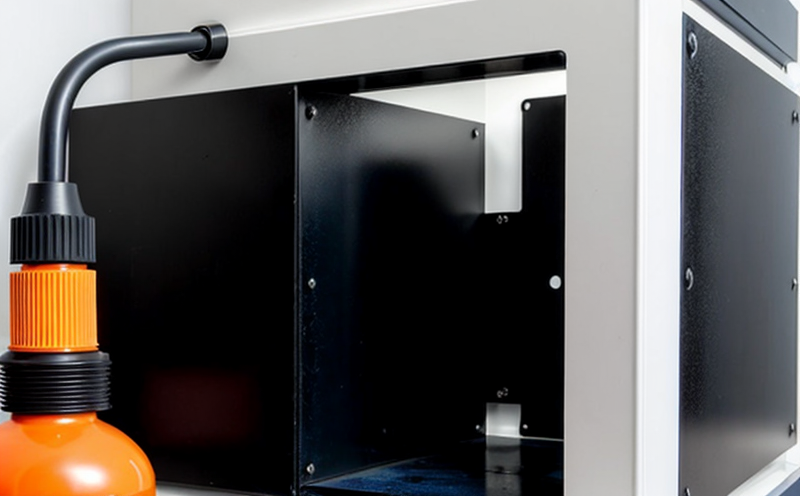ASTM G85 Salt Fog Corrosion Testing of Coated Surfaces
The ASTM G85 salt fog corrosion testing method is a widely recognized standard used to evaluate the resistance of coated surfaces, particularly in environments prone to atmospheric corrosion. This test simulates the corrosive effects of industrial atmospheres and saline conditions on coatings applied to materials such as metals, alloys, and certain plastics.
The ASTM G85 protocol involves exposing specimens to a controlled salt fog atmosphere for an extended period under specified conditions. The test is designed to provide insights into the performance of protective coatings in environments where chloride salts are prevalent. This method is essential for quality managers, compliance officers, R&D engineers, and procurement teams involved in ensuring product reliability and durability.
The testing process involves several key steps: specimen preparation, immersion in a salt fog chamber, exposure to the corrosive environment, and subsequent evaluation of any degradation. The test setup typically includes a chamber with controlled temperature, humidity, and salinity levels. Specimens are usually mounted on racks within the chamber, ensuring they are exposed uniformly to the fog.
The ASTM G85 standard specifies exact parameters for salt concentration (typically 5% NaCl), temperature (35°C ±2°C), and exposure duration. The test can be conducted under different conditions depending on the desired outcome: continuous exposure or cyclic immersion. The standard also provides criteria for evaluating coating integrity, such as blistering, cracking, or loss of adhesion.
Understanding the ASTM G85 salt fog testing is crucial for industries like automotive, aerospace, and marine, where coatings play a vital role in protecting materials from corrosion. For instance, in the automotive sector, this test ensures that paints and other protective coatings can withstand harsh environmental conditions, extending the lifecycle of vehicles.
Compliance with ASTM G85 is often a requirement for product certification, especially when exporting goods to countries like the United States and Europe where regulatory standards are stringent. This compliance not only enhances marketability but also ensures that products meet rigorous quality benchmarks.
International Acceptance and Recognition
- American Society for Testing and Materials (ASTM): ASTM G85 is an American national standard recognized globally. It sets the benchmark for salt fog testing, ensuring consistency across different laboratories.
- European Committee for Standardization (CEN): The European standard equivalent to ASTM G85 is EN 16734, which aligns closely with ASTM G85, providing a harmonized approach within Europe.
- International Organization for Standardization (ISO): While ISO does not have an exact counterpart to ASTM G85, the organization’s standards in corrosion testing are often referenced and complemented by ASTM methods like this one.
- United Kingdom: The British Standards Institution (BSI) also recognizes ASTM G85 for salt fog testing, ensuring its application is consistent across UK industries.
The widespread acceptance of ASTM G85 in international standards reflects its reliability and effectiveness in predicting real-world corrosion behavior. This recognition enhances the credibility of test results in global markets, making it a preferred choice for manufacturers and researchers worldwide.
Competitive Advantage and Market Impact
The ability to accurately predict and mitigate corrosion through ASTM G85 salt fog testing offers significant competitive advantages. By ensuring that coatings are robust against corrosive environments, companies can enhance product durability and reliability. This is particularly crucial in industries like aerospace and automotive, where the integrity of materials directly impacts safety and performance.
Compliance with ASTM G85 also opens doors to international markets, as it aligns with global regulatory standards. For instance, many countries require exporters to demonstrate compliance with specific testing methods before approving imports. By adhering to ASTM G85, companies can avoid costly rejections and delays at ports of entry.
The test results from ASTM G85 salt fog corrosion testing provide critical data for R&D engineers in developing new coatings that are more resistant to corrosion. This not only improves product quality but also contributes to environmental sustainability by reducing the frequency of maintenance and replacement.
For quality managers, the standard offers a clear framework for ensuring consistent coating performance across production batches. By using ASTM G85 as part of their quality control processes, they can identify potential issues early in the manufacturing process, leading to significant cost savings and improved product reputation.
Use Cases and Application Examples
The ASTM G85 salt fog corrosion testing is applicable across various sectors where coatings are used as a protective barrier against environmental elements. Some key use cases include:
- Aerospace Industry: Ensuring that aircraft components, especially those exposed to salty environments like landing gear and engine parts, maintain their integrity.
- Automotive Sector: Testing the durability of paint finishes on vehicles operating in coastal or industrial areas where salt exposure is common.
- Marine Industry: Evaluating coatings for ships and offshore structures that are frequently exposed to seawater and salt spray.
- Construction Materials: Assessing the protective coatings used on steel beams and other structural elements in coastal or industrial construction projects.
In each of these sectors, ASTM G85 provides a standardized method for evaluating coating performance. The test results are critical for manufacturers to make informed decisions about material selection and coating application techniques. By incorporating ASTM G85 into their quality assurance programs, companies can ensure that their products meet stringent international standards and perform reliably in challenging environments.





